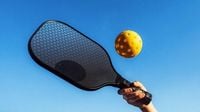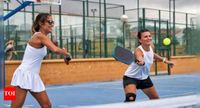Pickleball, the quirky paddle sport that’s taken America by storm, is now facing a sobering reality check. Once known primarily as a gentle pastime for retirees, the game has exploded in popularity, drawing nearly 20 million players in 2024 alone, according to NPR. But as courts fill up with enthusiasts of all ages—celebrities included—the risk of eye injuries has surged alongside the sport’s meteoric rise. Recent research published in JAMA Ophthalmology paints a clear picture: the fun can turn risky in the blink of an eye.
In a study highlighted by CTV News, researchers found that pickleball-related eye injuries have more than doubled between 2021 and 2024, now exceeding 400 cases annually—a dramatic increase compared to the previous decade. The numbers are even more striking when looking at the bigger picture. Between 2005 and 2024, an estimated 3,112 pickleball-related eye injuries brought Americans to emergency rooms, with roughly 1,262 of those cases occurring in 2024 alone, as reported by NewsNation. That’s a significant leap, considering there were no documented pickleball eye injuries before 2014, and only about 200 per year were reported between 2014 and 2021.
So, what’s behind this sharp uptick? Part of the answer lies in the sport’s accessibility and the influx of casual players. The study, published on October 19, 2025, in JAMA Ophthalmology, suggests that the recent wave of new players—many of whom play fewer than eight times a year—may be more susceptible to injury due to inexperience. “Although the increase in ocular injuries may simply reflect the increasing number of players, it is also possible that casual players are more susceptible to injury due to limited experience,” researchers wrote, as quoted by NewsNation.
Pickleball’s appeal is undeniable. It combines elements of tennis, badminton, and ping-pong, with simple rules and a low-impact design that draws people of all ages. Yet, the sport’s fast pace, small court, and hard plastic wiffle ball create a perfect storm for accidents. Dr. Matthew Gorski, an ophthalmologist at Northwell Health, told The Post, “People often think of pickleball as an easier sport. It may be lower velocity compared to other types of racquet sports, but it’s still a hard ball that moves fast. You’re in close quarters, and the court is much smaller than something like tennis.”
The injuries themselves range from minor to severe. According to NPR, cases include periocular lacerations (cuts around the eye), corneal abrasions, inflamed irises, and, in some instances, vision-threatening conditions like retinal detachments, globe trauma, orbital fractures, and hyphema. The statistics are particularly concerning for older adults: 70% of all reported injuries occurred in players aged 50 and above. Dr. Gorski explained, “Many older patients are not as agile to avoid trauma or contact from a ball or paddle or have pre-existing eye diseases that would put them at higher risk for a significant eye injury.”
The risks are not merely theoretical. In recent years, several high-profile injuries have brought the issue into the spotlight. Actress Michelle Pfeiffer, then 67, revealed in 2023 that she sustained a black eye while playing pickleball, while broadcaster Savannah Guthrie, 53, shared a similar story in 2022. These incidents underscore the reality that anyone, regardless of age or experience, can be vulnerable to injury on the court.
How do these injuries happen? The study, as summarized by NPR and The Times of India, breaks it down: 43% of injuries involved a direct hit from the ball, 28% resulted from falls, and 12% were caused by a paddle strike. The rest stemmed from various accidents that can occur in the heat of play. “A lot of people think that just because it’s a wiffle ball that you’re not going to get hurt,” said Dr. Corey Lacher, an ophthalmologist resident at Rutgers New Jersey Medical School and the study’s lead author, in an interview with NPR. “But, it’s still risky because everything is very fast-paced in pickleball and you’re playing on a very small court.”
Despite the growing number of injuries, eye protection remains optional in both casual and professional play. The JAMA Ophthalmology study strongly recommends “establishing standardized guidelines for eye protection” to reduce the risk of injury. Protective eyewear made of shatter-resistant polycarbonate and meeting the American Society for Testing and Materials (ASTM) F3164 standard is advised by experts like Dr. Gorski and Dr. Lacher. Such eyewear can reduce up to 90% of sports-related eye injuries, a statistic that’s hard to ignore.
But convincing players to don protective goggles isn’t easy. Dr. Natasha Desai, co-director for the Center for Women’s Sports Medicine at NYU Langone, told NPR that “getting players to wear eye protection is easier said than done.” Players may balk at the added cost, inconvenience, or simply lack awareness of the risks. Dr. Daniel Henick, an ophthalmology resident at Yale School of Medicine and an avid pickleball player, has researched why so few players use eye protection. He found that many simply aren’t aware of the potential dangers. Henick suggests that standardized guidelines, visible signage at courts, and encouragement from professional athletes could help shift the culture.
The call for action is clear. The study’s authors, as well as outside experts, urge the pickleball community to take the issue seriously. “We’re talking about hundreds, if not thousands, of injuries every year that could be prevented with what could be a relatively simple intervention,” said Dr. Henick to NPR. The paper acknowledges some limitations, such as a small sample size and reliance on emergency department databases that may not capture every incident. Still, the message is unmistakable: as pickleball’s popularity continues to soar, so too does the need for greater awareness and better safety measures.
For now, USA Pickleball—the sport’s governing body—has yet to respond to calls for standardized eye-protection guidelines. But with the evidence mounting and high-profile injuries making headlines, the push for change is gaining momentum.
Pickleball may be America’s fastest-growing sport, but its rise comes with challenges that can’t be ignored. As more players take to the courts, the simple act of grabbing a pair of goggles could prove to be the best defense against a game-changing injury.

